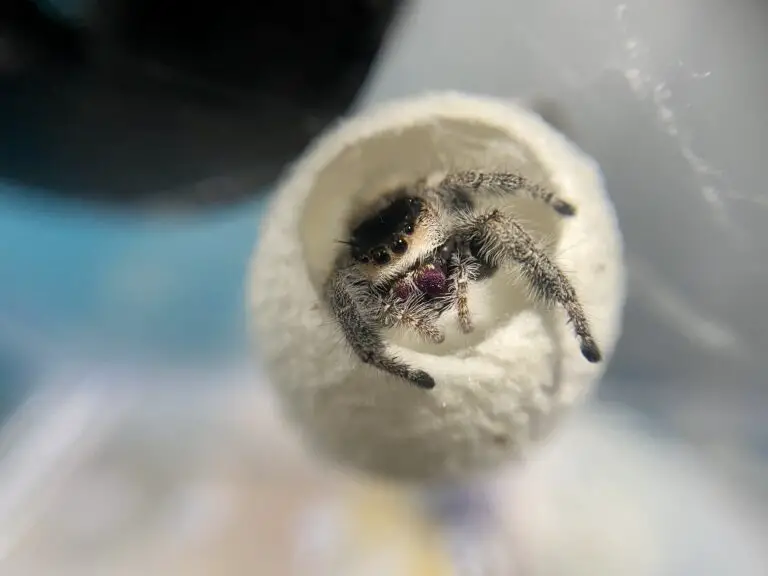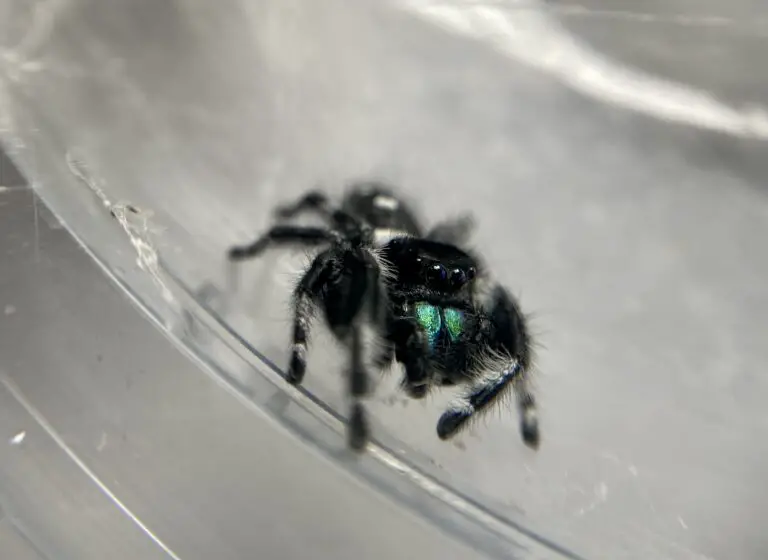Nine Interesting Facts About Jumping Spiders
Not everyone is a fan of spiders, but the jumping spider is definitely one of the cutest you can come across. As well as their appearance, they are much more interesting than a lot of spider species.
But don’t just take our word for it; the facts listed below should convince you that these little creatures aren’t average like the common house spider.
1. They Can Jump Up to 50 Times Their Body Length
Just as their name suggests, jumping spiders do actually jump! They are able to propel themselves through the air for distances that are up to 50 times their own body length. For a human, this would be the equivalent of jumping around 800 feet.
But how do jumping spiders manage such lengthy leaps? They have a pair of powerful back legs which they use to push off from the ground and launch themselves through the air. Their ability to jump comes from quickly straightening their back legs. This is a movement that is very similar to a catapult being released.
2. Jumping Spiders Don't Use Webs to Hunt
Most spiders will build webs in order to catch their prey, but jumping spiders are different. But the webs of jumping spiders are used very differently than most spiders; instead of being used to catch prey, they are used as a safety net in case the spider falls.
To hunt, these spiders will actually stalk and hunt down their prey before pouncing on them and injecting them with venom.
Jumping spiders are incredibly agile, so they are able to chase down even the quickest of prey. They will also use their excellent vision to spot potential victims from a distance; once they have found their target, they will patiently wait for the right moment to strike.
This hunting method is thought to be much more energy efficient for the spider as they don’t have to waste time and effort building webs that may not even catch anything.
3. They Have Excellent Vision
With four sets of eyes, it’s not a surprise that these spiders have superior vision. Their eyes form three rows; the largest pair and a medium pair on the front row, followed by two smaller eyes, then the last set of eyes.
This abundance of eyes gives them a 360-degree view of their surroundings, allowing them to spot any potential threats or prey. The largest pair of eyes (the principal eyes) are particularly special as they are able to see in ultra–high definition. This is thanks to the unique way that the light hits these eyes; it is reflected multiple times before it reaches the retina, resulting in a much clearer image.
Jumping spider eyesight is so good that they have even been known to spot and react to moving objects on television screens!
You can read more about jumping spiders’ eyes, and the rest of their anatomy, here.
4. They’re Not Dangerous to Humans
Thankfully, these cuties do not pose any threat to people. Jumping spiders are less likely to bite humans than other spider species as they are not naturally aggressive. However, they will bite if they feel threatened or if they are accidentally squished. For more information on jumping spider bites, click here.
Although their venom is strong enough to kill small prey, it would have no effect on humans for the most part as we are simply too big. In fact, their venom is actually less toxic than a bee’s sting!
So, if you’re ever lucky enough to come across one of these spiders, you can rest assured, knowing that they won’t hurt you.
The only thing you need to watch out for is if you’re allergic to their bites. In rare cases, some people may experience redness, swelling, and itchiness. However, this is not common and is nothing to worry about.
5. Jumping Spiders Are Found on Every Continent Except Antarctica
These spiders are native to warm climates but can now be found on every continent except for Antarctica. They are commonly found in gardens and forests and are often seen on the leaves of plants and trees.
There are over 6000 species of jumping spider, from the regal jumping spider to the zebra jumping spider, so they come in all sorts of shapes and sizes. However, they all share the same unique features, such as their large principal eyes and their ability to jump long distances. This means, that no matter where you are, you should be able to spot a jumping spider by its distinctive features.
6. They Mimic Other Insects
Jumping spiders are masters of disguise and are often able to mimic the appearance of other insects. This is a great way for them to avoid being eaten by predators or to surprise their prey.
For example, some species have evolved to look like ants as these are often left alone by predators. Some jumping spiders even go as far as to wave their legs in the air to imitate the movement of an ant’s antennae.
7. Jumping Spiders Dance Really Well
You may not have seen a jumping spider dance before, but they are actually really good at it! Males will often perform a special dance to impress females and persuade them to mate.
The dance involves the male moving his legs and body in a wave–like motion. He will also vibrate his abdomen and make special noises by rubbing his legs together. If the female is impressed, she will mate with him. Male spiders are much more likely to avoid being eaten before mating with a female if they performs well, too.
If you’re ever lucky enough to see a jumping spider dance, particularly a peacock spider, you’ll be sure to be impressed by their moves!
8. They Can Live Up to Two Years
In the wild, jumping spiders usually only live for around one year. However, in captivity, they have been known to live for up to two years. This might be due to less risk of predators and more consistent feeding.
This is much longer than most other types of spiders, which is just another reason why they make such great pets!
9. Jumping Spiders Can Make Great Pets
Because of their long lifespan and friendly nature, jumping spiders make great pets. They are also very easy to care for, so even if you’ve never had a pet spider before, you should be able to take care of one with ease.
If you’re thinking of buying a jumping spider as a pet, be sure to do your research first to make sure you can provide everything they need; this resource will hopefully be a good starting point.


